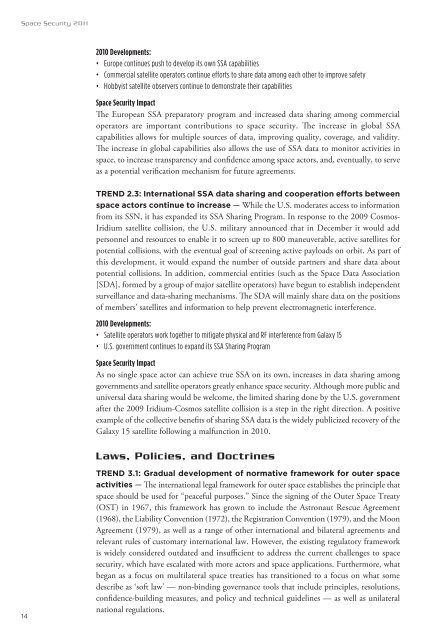Space Security Index
Space Security Index
Space Security Index
You also want an ePaper? Increase the reach of your titles
YUMPU automatically turns print PDFs into web optimized ePapers that Google loves.
<strong>Space</strong> <strong>Security</strong> 2011<br />
14<br />
2010 Developments:<br />
• Europe continues push to develop its own SSA capabilities<br />
• Commercial satellite operators continue efforts to share data among each other to improve safety<br />
• Hobbyist satellite observers continue to demonstrate their capabilities<br />
<strong>Space</strong> <strong>Security</strong> Impact<br />
e European SSA preparatory program and increased data sharing among commercial<br />
operators are important contributions to space security. e increase in global SSA<br />
capabilities allows for multiple sources of data, improving quality, coverage, and validity.<br />
e increase in global capabilities also allows the use of SSA data to monitor activities in<br />
space, to increase transparency and condence among space actors, and, eventually, to serve<br />
as a potential verication mechanism for future agreements.<br />
TREND 2.3: International SSA data sharing and cooperation eorts between<br />
space actors continue to increase — While the U.S. moderates access to information<br />
from its SSN, it has expanded its SSA Sharing Program. In response to the 2009 Cosmos-<br />
Iridium satellite collision, the U.S. military announced that in December it would add<br />
personnel and resources to enable it to screen up to 800 maneuverable, active satellites for<br />
potential collisions, with the eventual goal of screening active payloads on orbit. As part of<br />
this development, it would expand the number of outside partners and share data about<br />
potential collisions. In addition, commercial entities (such as the <strong>Space</strong> Data Association<br />
[SDA], formed by a group of major satellite operators) have begun to establish independent<br />
surveillance and data-sharing mechanisms. e SDA will mainly share data on the positions<br />
of members’ satellites and information to help prevent electromagnetic interference.<br />
2010 Developments:<br />
• Satellite operators work together to mitigate physical and RF interference from Galaxy 15<br />
• U.S. government continues to expand its SSA Sharing Program<br />
<strong>Space</strong> <strong>Security</strong> Impact<br />
As no single space actor can achieve true SSA on its own, increases in data sharing among<br />
governments and satellite operators greatly enhance space security. Although more public and<br />
universal data sharing would be welcome, the limited sharing done by the U.S. government<br />
after the 2009 Iridium-Cosmos satellite collision is a step in the right direction. A positive<br />
example of the collective benets of sharing SSA data is the widely publicized recovery of the<br />
Galaxy 15 satellite following a malfunction in 2010.<br />
Laws, Policies, and Doctrines<br />
TREND 3.1: Gradual development of normative framework for outer space<br />
activities — e international legal framework for outer space establishes the principle that<br />
space should be used for “peaceful purposes.” Since the signing of the Outer <strong>Space</strong> Treaty<br />
(OST) in 1967, this framework has grown to include the Astronaut Rescue Agreement<br />
(1968), the Liability Convention (1972), the Registration Convention (1979), and the Moon<br />
Agreement (1979), as well as a range of other international and bilateral agreements and<br />
relevant rules of customary international law. However, the existing regulatory framework<br />
is widely considered outdated and insucient to address the current challenges to space<br />
security, which have escalated with more actors and space applications. Furthermore, what<br />
began as a focus on multilateral space treaties has transitioned to a focus on what some<br />
describe as ‘soft law’ — non-binding governance tools that include principles, resolutions,<br />
condence-building measures, and policy and technical guidelines — as well as unilateral<br />
national regulations.

















